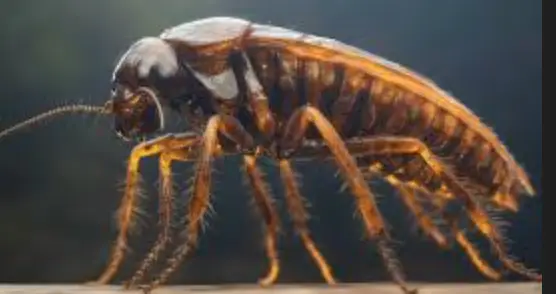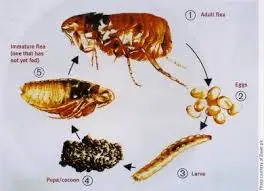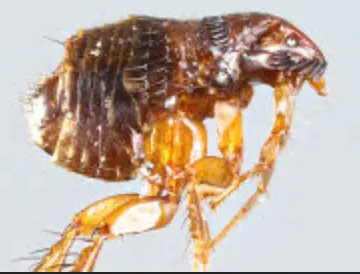Last Updated on 05/01/2025 by Kimberly
Can fleas fly? No, fleas are small, wingless insects that are infamous among pet owners and homeowners. Despite their tiny size, these pests cause significant discomfort and problems by feeding on the blood of mammals and birds. Understanding the nature and behavior of fleas is crucial for effective control and treatment.
Physically, fleas are built to survive and thrive. They have a tough exoskeleton that protects them from being crushed, and their body is laterally compressed, making it easier for them to move through the fur of animals. Their size ranges from 1.5 to 3.3 millimeters, making them difficult to notice until an infestation grows.
Watch The Following Video To Better Understand How Fleas Move
For pet owners, being aware of flea behavior can make all the difference in managing infestations. Fleas are not only a nuisance but also a vector for various diseases. Knowing their habits, like how and why they move, helps in formulating a more effective eradication plan.
Recognizing the environmental conditions that support flea populations is also essential. Fleas thrive in warm, humid environments and are often found on pets, as well as in carpets, bedding, and upholstery. These pests are adept at hiding and can proliferate quickly, leading to a full-blown infestation in no time.
By understanding these basics about fleas, you can take the first steps toward managing them effectively.
Can Fleas Fly? No, But The Remarkable Jumping Ability of Fleas Makes It Seem Like They Can
Unlike many other insects, fleas don’t have wings. Instead, they rely on their exceptional jumping ability to get around. Fleas are equipped with powerful legs that allow them to leap distances up to 1000 times their own height. To put that into perspective, it’s like a human jumping over a 100-story skyscraper.
This impressive jump is made possible by the flea’s unique biological design. Fleas store energy in a protein called resilin, found in their legs. When they release this stored energy, it propels them into the air with remarkable speed and precision. This mechanism is not just for show – it’s essential for their survival. Jumping helps fleas find food and escape threats quickly.
Comparing a flea’s jump to other insects highlights just how extraordinary it is. While many insects can fly or run quickly, the flea’s jump is a specialized adaptation that allows it to evade predators and find new hosts rapidly. Even though they lack wings, their leaps allow them to cover ground quickly and efficiently.
Knowing about a flea’s jumping ability is useful in flea control. Understanding their movements helps you spot the signs of an infestation and take appropriate actions. For instance, seeing small, black dots leaping from your pet’s fur or around your home is a good indicator that fleas might be present. Recognizing these signs early can help you address the issue before it becomes a full-blown problem.
The Biology of Fleas: No Wings, Only Legs
Fleas are fascinating when you examine their anatomy. One of the first things to note is that they are wingless. This absence of wings is a significant reason why fleas rely on jumping as their primary mode of movement. Instead of wings, fleas have six legs, each specially adapted for jumping and clinging to hosts.

A flea’s legs are incredibly strong relative to its size. These legs are segmented and end in sharp claws that help fleas firmly attach to their host. The hind legs, in particular, are designed for locomotive power. These legs contain the resilin protein, mentioned earlier, which acts like a spring to launch fleas into the air.
This robust leg structure serves multiple purposes. It helps fleas quickly find a host, evade danger, and navigate through the dense fur of animals. Apart from their legs, fleas have a flattened body, allowing them to move easily through their host’s fur or feathers and making them hard to dislodge.
Understanding why fleas cannot fly but can jump so well provides valuable insights into their behavior and how they spread. Their anatomy is fine-tuned for survival and efficiency, enabling them to feed, reproduce, and avoid threats effectively. Knowledge of their physical capabilities sheds light on how best to address a flea problem. Treating a flea infestation isn’t just about targeting adult fleas but understanding that their ability to move and hide impacts eradication strategies.
By comprehending their biological makeup, you can better navigate the steps needed to control and prevent flea infestations. Targeting the fleas’ environment and comprehending their strengths and weaknesses can help you take more informed and effective measures.
Flea Life Cycle and Behavior
Fleas go through four distinct stages in their life cycle: egg, larva, pupa, and adult. Each stage presents different challenges for effective control. Eggs are laid on the host but often fall off into the environment—like your pet’s bedding or your carpet. These eggs hatch into larvae, which feed on organic matter, including adult flea feces, providing them with the energy to spin cocoons and transition into the pupal stage.
The pupa stage is particularly tough to handle. In this phase, fleas are encased in a sticky, protective cocoon that shields them from many treatments. Pupae can remain dormant for extended periods, waiting for the right conditions, such as a potential host’s movement, heat, and carbon dioxide, to trigger their emergence as adults.
Once adult fleas emerge, they seek out a host to feed on and quickly reproduce. A single flea can lay up to 50 eggs per day, starting the cycle anew. This rapid reproduction is why spotting a single adult flea often means there are many more in various stages of development around your home.
Behaviorally, fleas are well-equipped to find food and avoid danger. They have sensory organs that detect cues from potential hosts, enabling them to jump towards these signals. This ability to detect and move towards food sources makes them persistent pests, especially in households with pets.
Recognizing the presence of fleas early on is crucial. If you spot adult fleas, it typically indicates an active life cycle happening in your home. Immediate action can prevent a minor issue from escalating into a significant infestation.
Effective Flea Control Strategies: Breaking the Life Cycle
To successfully combat fleas, it’s essential to target all stages of their life cycle. This involves a multi-faceted approach, starting with treating your pets. Flea treatments like topical solutions, oral medications, and flea collars can provide immediate relief and prevent future infestations. Always consult your veterinarian to choose the most effective and safe treatment for your pet.
Treating the home environment is equally crucial. Since flea eggs and larvae can settle in carpets, pet bedding, and furniture, using vacuum cleaners regularly can help. Steam cleaning these areas and washing pet bedding in hot water are effective ways to eliminate these stages. In more severe infestations, insect growth regulators (IGRs) can disrupt the flea life cycle by stopping larvae from maturing into adults.
Don’t forget about the outdoor area. Fleas thrive in shaded, humid places like tall grass and gardens. Keeping your lawn mowed, trimming bushes, and removing debris can reduce flea habitats. Insecticides labeled as safe for outdoor use can be applied to these areas to further reduce flea populations.
Prevention is always better than treatment. Regularly grooming your pets and checking them for fleas can catch early signs before they become a significant problem. Additionally, maintaining a clean living environment lowers the chances of re-infestation.
Breaking the flea life cycle requires consistent effort. By addressing both the host and their surroundings, you’re more likely to succeed in keeping your home flea-free.
In Conclusion To The Question Can Fleas Fly?
I hope you found the information about whether fleas could fly interesting and that it answered your questions. If you have any questions about any of the information above, please leave them in the comments section. If you have any information about fleas that you would like to share with everyone, please leave them in the comments section as well.
Thank you for visiting Fleas B Gone, have a great day 🙂






